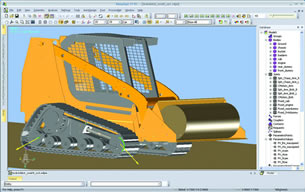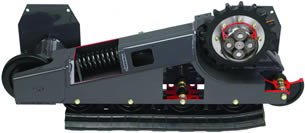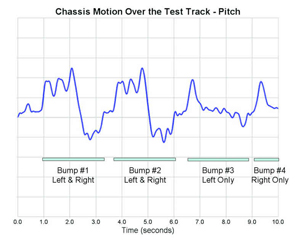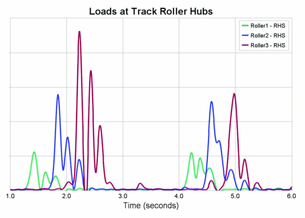Latest News
March 4, 2009
By Brant Ross
Case New Holland compact track loader simulations help manufacturer keep pace with evolving products.
Case New Holland (CNH), a leading agricultural and construction equipment company that is part of the Fiat Group, is increasing its motion simulation capabilities as its product
 This screenshot shows outputs obtained from the RecurDyn simulations illustrating loads on the front and rear idlers during a pivoting maneuver. The yellow arrows indicate the vector force on the hubs and the green arcs indicate the torque acting on the hubs. Watch the video below.
This screenshot shows outputs obtained from the RecurDyn simulations illustrating loads on the front and rear idlers during a pivoting maneuver. The yellow arrows indicate the vector force on the hubs and the green arcs indicate the torque acting on the hubs. Watch the video below.designs evolve. One example is the design of compact track loaders that were developed to provide increased traction and reduced ground pressure as compared to traditional skid-steer loaders with tires. The Case 450CT compact track loader has 82 net horsepower (61 kW) with a 3,857-lb. lift capacity. The addition of a track system adds additional moving components to a compact track loader, including the band track. The flexible behavior of the band track must be taken into account as well as its contact with the front and rear idlers and a number of track rollers. An engineering advantage of using a track system is that only one drive shaft is needed for each side, as compared to the two drive shafts per side that are used to provide the four-wheel drive of a typical skid-steer loader.
The undercarriage of the compact track loader incorporates features that CNH developed over many years of experience with large excavators and crawler dozers. The affected components include the track, rollers, idlers, seals, track tension adjustment, and final drives. For example, the loader features track rollers with three flanges and two sets of center-guide lugs on the track in order to prevent de-tracking when the loader is operating along the side of a slope.
 The undercarriage of the compact track loaders incorporates features that CNH developed in their many years of experience with large excavators and crawler dozers.Images courtesy CNH The undercarriage of the compact track loaders incorporates features that CNH developed in their many years of experience with large excavators and crawler dozers.Images courtesy CNH |
The development of a durable tracked vehicle requires load data for the track components and the track structure. Physical testing of a compact track loader is challenging because it is difficult to instrument the track due to track flexing and its contact with undercarriage components. Instrumentation is further complicated by debris that comes in contact with the undercarriage during testing in soil conditions. CNH developed a special test track for impact loading by creating a grid of pipes that the loader would traverse. The pipes are located to apply various combinations of loads on the left and right track assemblies. Because it can be more effective to obtain certain product performance data through motion simulation, CNH selected the RecurDyn motion simulation software from FunctionBay some years ago and later added the RecurDyn tracked vehicle toolkit to support the compact track loader development. RecurDyn simulates detailed models quickly because it uses a recursive formulation to develop the equations of motion. In addition, the RecurDyn toolkits automate the modeling process to increase efficiency and reduce errors. For example, the band track is modeled as series of segments. The automated tasks include the definition of the segments, the flexible properties of the segments, the contact between each segment and the various undercarriage components, and the generation of track-specific outputs.
 The lower plot shows the pitching motion of the loader chassis. The relationship of the pitching of the chassis and the roller loads at approximately 2.0 and 4.5 seconds is interesting.
The lower plot shows the pitching motion of the loader chassis. The relationship of the pitching of the chassis and the roller loads at approximately 2.0 and 4.5 seconds is interesting.The implementation of the motion simulation tool begins with the import of geometry from CNH’s CAD system, Pro/ENGINEER from PTC. The track system on each side of the loader is modeled separately using the RecurDyn track toolkit. Developing a model with separate track assemblies was facilitated by the RecurDyn’s hierarchical data structure. Each track assembly is defined and checked in a separate “subsystem” of the model. The subsystems are associated with the vehicle chassis and the entire vehicle is simulated with selected terrain at the top model level. The process enabled a fast model development, which was necessary to attain performance information in time to affect product design. As each loader model is developed it is taken through “worst-case” maneuvers that correspond to physical tests, including impact testing. The CNH 450CT team uses the simulation outputs to understand how various maneuvers and operations affect the forces on the track components and frame. Model parameters are adjusted until the model matches the physical test data, using force data that can be readily measured. The validation process gives credibility to the model outputs that are not available or verifiable from physical testing.
Once the model is validated, the load data can be used with standard FEA software to determine peak stresses in the track and vehicle structure. The identification of the component stresses during worst-case conditions yields a set of opportunities to improve product durability. Key design parameters for the undercarriage components are defined and sensitivity studies are completed to develop recommendations for further improvements to the loader design. Improvements may be made at the system or component level. Examples of system level improvements may include changed placements of roadwheels in the track assembly, a changed center of mass location for the vehicle, or a changed track tension. An example of a component level improvement is the addition of material in locations of high stress.
Kezhun Li, manager of Digital Prototyping and Simulation at CNH, says, “RecurDyn’s computational speed and process automation for track systems allowed us to develop accurate simulations of our compact track loaders that would have not otherwise been practical. Although we are continuing to gather data, we are confident that we are reducing our engineering costs by at least two dollars for every dollar that we invest in simulation.” CNH Project Engineer Adam Ewing says, “It would have taken a large investment of money and time to obtain the needed data through physical tests. The simulation results were obtained quickly and helped us focus on the areas of the design where we could improve the performance in the field.”
Case New Holland Milan, Italy
FunctionBay Seoul, Korea
PTC Needham, MA
MotionPort Ypsilanti, MI
Subscribe to our FREE magazine, FREE email newsletters or both!
Latest News







